Product Description
Human Electrogenic sodium bicarbonate cotransporter 4 (SLC4A5) ELISA Kit | AE18464HU | Abebio
Species Reactivity: Human (Homo sapiens)
Abbreviation: SLC4A5
Alternative Name: MGC129662; NBC4; OTTHUMP00000115292|sodium bicarbonate transporter 4
Application: ELISA
Range: 0.312-20 ng/mL
Sensitivity: 0.119 ng/mL
Intra-Assay: ≤4.1%
Inter-Assay: ≤7.5%
Recovery: 0, 99
Sample Type: Serum, Plasma, Other biological fluids
Detection Method: Sandwich
Analysis Method : Quantitive
Test Principale: This assay employs a two-site sandwich ELISA to quantitate SLC4A5 in samples. An antibody specific for SLC4A5 has been pre-coated onto a microplate. Standards and samples are pipetted into the wells and anySLC4A5 present is bound by the immobilized antibody. After removing any unbound substances, a biotin-conjugated antibody specific for SLC4A5 is added to the wells. After washing, Streptavidin conjugated Horseradish Peroxidase (HRP) is added to the wells. Following a wash to remove any unbound avidin-enzyme reagent, a substrate solution is added to the wells and color develops in proportion to the amount of SLC4A5 bound in the initial step. The color development is stopped and the intensity of the color is measured.
Product Overview: SLC4A5 is a member of the sodium bicarbonate cotransporter (NBC) family, part of the bicarbonate transporter superfamily. Sodium bicarbonate cotransporters are involved in intracellular pH regulation and electroneural or electrogenic sodium bicarbonate transport. This protein is thought to be an integral membrane protein. Multiple transcript variants encoding different isoforms have been found for this gene, but the biological validity of some variants has not been determined.Highest expression observed in liver, spleen and testis; moderate expression in the choroid plexus, hippocampus, cerebrum and cerebellum of brain, and in kidney cortex and kidney medulla. Also observed in heart, pancreas, muscle, lung, placenta, stomach and small intestine.
Stability: The stability of ELISA kit is determined by the loss rate of activity. The loss rate of this kit is less than 5% within the expiration date under appropriate storage condition. The loss rate was determined by accelerated thermal degradation test. Keep the kit at 37°C for 4 and 7 days, and compare O.D.values of the kit kept at 37°C with that of at recommended temperature. (referring from China Biological Products Standard, which was calculated by the Arrhenius equation. For ELISA kit, 4 days storage at 37°C can be considered as 6 months at 2 - 8°C, which means 7 days at 37°C equaling 12 months at 2 - 8°C) .
 Euro
Euro
 USD
USD
 British Pound
British Pound
 NULL
NULL












